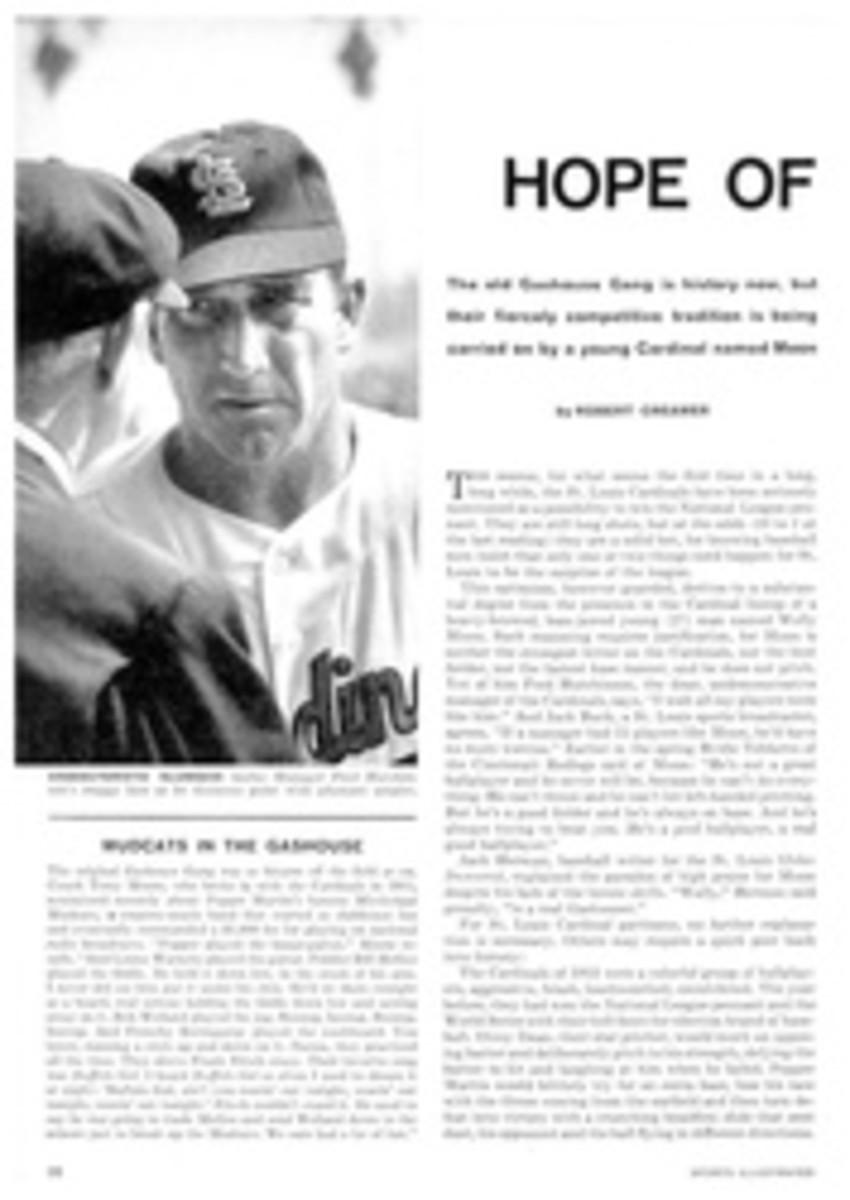
FOOTLOOSE SPORTSMAN IN THE SMOKIES
The mountain village of Gatlinburg at the main gateway of Great Smoky Mountains National Park offers a handsome assortment of motels, hotels, mountain beaneries, candy kitchens that turn out edible dogwood blossoms and other necessities of the tourist in the field.
Gatlinburg is a settlement that grew from bare feet to Cadillacs in one generation, or so they say down in the hills. Anyway, since the formal dedication of the park in 1940, most of the people are not merely shod but well-heeled. The local telephone directory, while hardly thicker than a theater program, lists 57 Ogles, 28 Reagans, 21 Trenthams, 15 Whaleys—not to mention the assorted Huffs and Maples—who between them own 85% of the place. Almost any sunny afternoon, now that spring is here, one can pass the time ogling the assorted Ogles who sit in front of the Ogle Supermarket ogling all the girls who go by.
Through the soft spring air comes the hypnotic whooshing of the Little Pigeon River as it rushes through town over a carpet of stone, forming islands on which the townsfolk have built pleasant riverside motels. One of the pleasantest is Twin Islands, which offers duplex drive-ins fitted with oak paneling and green-tinted glass on the windows, at $16 a summer's night. Its Honeymoon Islands is inhabited by four secluded units with floor-to-ceiling glass walls at $10 a night. There is a pool for swimming (one of a score in town), and a fisherman with a license can drop a legal line into Little Pigeon now that the hornyheads are, as they say, a-flutterin'.
Motels and a quartet of bona fide hotels are shoulder to shoulder along Parkway, a main street bordered with dogwood that erupts with the wane of April into pinkish popcorn. The Bearskin Motel, which, like most of the better drive-ins in Gatlinburg, has air conditioning and TV in every room, gets $12 a night at the top of the season for a room with two double beds. Rustic cabins that are cooled by air conditioning and heated by a fireplace cost $11 for a two-room suite sleeping three. Honeymoon cottages are $8. And the fare includes continental breakfast.
The four hotels, namely the Mountain View, the Greystone, the Riverside and the New Gatlinburg Inn, offer among them probably the best values of any resort town in the country today. Although most will take guests with or without meals, their American plan rates run from $8 to $12 a day. Most have air-conditioned rooms. The Mountain View has 100 pine-paneled rooms. The Greystone, aside from its main house, offers super-plush patio rooms of rich Oregon spruce and lavender Tennessee marble, with one wall of sliding glass panels opening to a private patio. The price is $15 a day with meals, and you can have them served chez vous in an electric cart upon payment of a supplemental tithe. The dining room of the Riverside opens onto the pool, and the New Gatlinburg Inn, which offers only European plan rates, has one of the best kitchens in town dispensing rainbow trout and hush puppies and roast beef dinners, all served with hot southern breads, mountain honey and desserts from the tray, the whole works for less than $3. A sky lift sails upward alongside the New Gatlinburg to Crockett Mountain, and the hotel has a picnic area for guests on Little Pigeon River. It will also arrange horseback riding at Bear Wallow Dude Ranch, two miles off in the hills.
Although there are no outstanding restaurants in town there certainly is one inescapable dish—country ham which arrives floating in red-eye gravy. (The red eye, made from the juices and fat of the ham itself, is a delight when sopped up in hot biscuits, but the country ham which, for reasons that escape me, sells for $2 a pound in the butcher shop, tastes like nothing so much as salted briefcase.) Nominations from this department would include the New Gatlinburg Inn's dining room; Sweden House, a branch of the Chicago house of herring by the same name; and Hays's, which serves a family-style all-you-can-eat-for-$1 lunch, under a rotating art exhibit hung on the burlap-covered walls.
Beer with a brogue
There is a tavern in the town, but just one, and it is called Frank's after the owner, whose windows are decorated with geraniums and whose speech is spiced with a brogue. Beer is the only legal libation. Anyone in need of a stronger cure can repair to the Elks Club. Most local innkeepers are members, and privileges are extendible.
Watching the candymakers whose kitchens are scattered along Parkway has become such a spectacular sport that some taffy-pullers have had to put up railings to protect their plate glass. Old Smoky Candy Kitchen turns out lemon-pecan divinity, licorice marshmallow cream caramels and other inducers of avoirdupois, while across the street the Old Cane Mill dispenses marzipan ham-and-eggs in a frying pan, Davy Crockett bear steaks and candy salami put together—Lindy's should pardon me—of coconut, cashew nuts and chocolate. Aunt Mahalia's candy place, home of the edible dogwood blossoms, makes stick candy by hand each night, and last year the show attracted so many people that a portrait artist showed up and made sketches of visitors while they watched the exhibition.
The craftshops, of which the Beta Phi Phi Arrow Craftshop probably offers the best selection, offer hand-blown glass from West Virginia, wood carvings, brooms, hooked chair mats and other indispensables. There are fine wood pieces at the Wood Whittlers, who will copy anything from the ark to a wooden nickel in anything from black walnut to black gum.
Husbands who eschew flower-sniffing will find the new Gatlinburg Golf Course a day's exercise indeed. Built in the foothills of the mountains, it already has tunneled under one hill and is being pressured into installing a sort of golfers' ski tow that will pull the player from one low-lying green to the next steep tee.
As for the local fishing, the record trout, a brown, brought in last year, weighed nine pounds. There are over 600 miles of fishing streams in the park itself, with the best of the go at Hazel, Forney, Cataloochee and Big Creek, all of which require a hike. On two park streams, Bradley and Little Pigeon, the fishing is for fun only. The park season runs from May 16 to Auggust 31, but it is only 23 miles to the TVA Douglas Lake for all-year-round bass, crappie, pike and bream.
One way of exacting a promise of docility from the Kinder is to propose a visit to the Cherokee Indian Reservation, which juts into the park on the south. Cherokees in Sioux headdress twirl lassos in front of the braves' bazaars, but a more representative idea of Cherokee life can be seen at the Oconaluftee Indian Village and in the outdoor pageant Unto These Hills, which concerns the days when the Cherokee Indians were deported from the area. (Another pageant, Chucky Jack, played in a new outdoor theater near Gatlinburg depicts the beginnings of Tennessee.)
For those who would rather be cowboys, the Cataloochee Ranch, which takes just 30 guests, is a 1,000-acre preserve adjoining the park at Waynesville, N.C. Like half a dozen other operators, the ranch dispatches horses and pack trips into the park. Also on the North Carolina side is famous Fontana Village, a gigantic spread with room for 1,200 guests complete with cafeteria, dining room, and supermarket for do-it-yourself living. There are a theater, playground, swimming pools, a boat dock for cruising on Fontana Lake (which has no closed season on fishing) and riding stables. Fontana is 77 miles from Gatlinburg.
There is seclusion at Le Conte Lodge, an inn stuck in the crags of the Smokies and reachable only by horse or foot. A seven-mile uphill stroll, Le Conte has room for 40 and is owned by Jack Huff of the Mountain View Hotel in Gatlinburg. Finally, there are five campgrounds where anyone who feels like Davy Crockett can pitch his tent and play King of the Wild Frontier—with water taps, picnic tables, fireplace, comfort station and a concessionaire who sells wood, operating conveniently just alongside.

